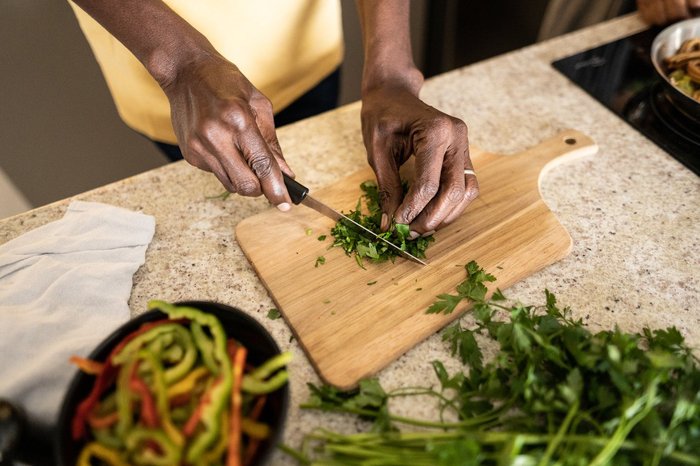Add herbs
Herbs add buckets of flavour, and they’re safe to eat if you have chronic kidney disease (CKD), says dietitian Laura Kyte.
Soft herbs taste better fresh: add basil to pasta sauce, flat-leaf parsley to salads, or a sprinkle of coriander leaves to chilli, coconut curries or stir-fries.
A little goes a long way with strong-flavoured herbs like tarragon, which has an aniseed flavour. “I like adding a teaspoon of chopped tarragon to a fish pie. It also goes well with chicken,” says Laura. (Check out the delicious Kidney Kitchen Chicken, leek and tarragon pie).
Make fresh herbs go further by rinsing, chopping, and placing them into sections of an ice cube tray. Top with water and freeze, then defrost 1-2 cubes in a small bowl and add to soups and stews.
Woody herbs, like rosemary, oregano and thyme are tasty fresh or dried, making them great value. Stir 1tsp into a lamb stew or sprinkle over veggies before roasting them.

Spice it up
Bring variety to mealtimes with spices.
Ground cumin, turmeric and coriander all add earthy notes to chilli and curries (add 1-2tsp to the pot after you’ve softened the onions and stir for 1-2 mins until fragrant).
Punchy smoked paprika is a great alternative to salt: combine half a teaspoon with two tablespoons of plain yogurt and a squeeze of lime for a low-sodium alternative to mayo. “I often recommend the spice asafoetida as a good salt alternative, as it has a subtle onion flavour,” says Laura. “Always check the label on mixed spice blends and chilli powders, in case of added salt.”
Savour the flavour
Umami is that satisfying ‘savouriness’ in ingredients like parmesan, cheddar, Marmite or soy sauce. Unfortunately, umami and added salt often go hand in hand, so switch to clever alternatives.
“Mustard powder is a good addition to dishes for a savoury kick,” suggests Laura. Add one teaspoon to a white sauce for fish pie or macaroni cheese, or a pinch to a homemade dressing. Check the label on jarred mustard, as the levels of added salt vary.
Nutritional yeast is loved by vegans for its savoury, cheesy flavour, so use it to make a plant-based sauce or to beef up the flavour of dishes where you’ve reduced the amount of cheese. “Opt for strong cheese like very mature cheddar and use a matchbox-sized amount,” says Laura.
Take stock
Stock cubes add instant flavour to gravies, soups, and stews, but can be high in salt.
“Look for ‘very low’ or ‘zero salt’ stock cubes,” says Laura.
In the Kidney Kitchen, we usually use Kallo Very Low Salt stock, but you could also try Knorr Zero Salt sock cubes.
Be careful with Oxo 25% Less Salt – it’s not actually a low-salt option, just a reduced-salt version, which isn’t the same thing. Also note that Oxo replaces some of the salt with potassium chloride. This is something people with CKD may need to limit or avoid because it can affect potassium levels in the body.
Why not try making your own vegetable stock or chicken stock, so you can control exactly what’s in it? Place a roasted chicken carcass in a large cooking pot and follow a chicken stock recipe. “Store spare homemade stock in the freezer and defrost before using it,” says Laura.
The big squeeze
Citrus lifts the other flavours in a dish.
Try a squeeze of lime on a stir fry or stir it through a creamy coconut curry just before serving.
Perk up salad leaves with a homemade salad dressing of lemon juice and olive oil (use one part juice to three parts oil).
Look for unwaxed lemons and limes, so you can grate the zest into dishes (try a little lemon zest in homemade chicken soup).

Make veg the star
Cooking with ripe, flavourful seasonal fruit and veg adds variety to your cooking. Think tender asparagus in spring, ripe summer corn, autumn’s squash, or winter’s cabbages and sweet parsnips.
Don’t overlook tinned and frozen veg, though. Some veggies, like frozen peas, arguably taste better as they’re frozen straight after harvesting, preserving all that lovely sweetness. Try frozen peas stirred into a risotto, added to omelettes or Thai curry.
Switch from canned chopped tomatoes to plum ones which have a more intense flavour, recommends Laura (though proceed with caution if you need to limit potassium and check the label in case of added salt).
Garlic and onion are essential flavour boosters. Make easy pasta sauce by simmering one diced onion and two crushed garlic cloves with olive oil on a low heat until softened, then add the plum tomatoes.